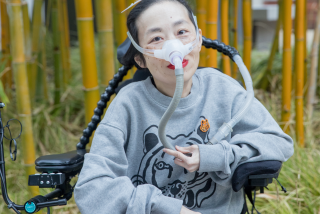Photographer With Polio Documents China Disabled
- Share via
BEIJING — Before Wang Tao was allowed to enter primary school, he had to prove he could walk.
“That was the first time I realized how other people looked at me,” said Wang, a polio victim who gets around with crutches and a three-wheeled motorcycle.
Wang is an award-winning photographer for Bridge, a feature magazine. He is documenting the lives of China’s 51 million disabled people, the most of any nation.
“Photography puts great physical demands on a normal person, let alone a disabled person,” he said. “I wanted to prove I could do this even better” than people without disabilities.
His photos illustrate everyday problems the disabled face in China.
Only two streets in Beijing have wheelchair ramps, for example, and there are few toilets with large stalls and support bars. Public buildings, buses and subways are not designed with the handicapped in mind.
In the past, Chinese families would hide the disabled because they considered them a disgrace.
Society spared few resources for treatment, education or rehabilitation. Most of the disabled were given little or no education and could find only menial work.
Many still do menial work or beg on the streets, particularly in areas frequented by foreigners.
Half a dozen beggars, blind or with limbs missing, appear regularly on a sidewalk near a special store for foreigners in Beijing. Some foreigners give them money, but Chinese rarely do.
Treatment of the disabled has improved over the last decade as the economic reforms of Deng Xiaoping bettered living conditions for everyone.
Their cause has been aided by the senior leader’s son Deng Pufang, whose legs were paralyzed when he fell from a window during the radical Cultural Revolution in the 1960s. He is chairman of the China Disabled Persons’ Federation, formed in 1988.
China promulgated its first law for the disabled in May, including rights to education and jobs. The law was accompanied by a monthlong propaganda campaign and visits by top leaders to schools and factories for the disabled.
In urban areas, disabled people no longer are hidden. Children are taken on school outings and, in Beijing, some paraplegics work as news vendors.
Less progress has been made in the countryside, where 800 million of China’s 1.13 billion people live. The newspaper Wen Hui News told of a farmer who starved his disabled, deaf 6-year-old son because the boy was a burden.
Wang began fighting for his rights 30 years ago, at age 6.
His first major task was getting into primary school. Officials refused to accept him until he walked around the school track.
Regular universities would not take him, pleading lack of elevators, ramps and other facilities. He enrolled in night school and took television courses, earning degrees in both Chinese and English studies.
As a photographer, Wang has traveled to all but one of China’s 30 provinces, negotiating deserts and mountains on his crutches.
His work has won national awards, and “China’s first wheelchair photographer” was featured in a documentary film.
He recently visited Zhang Tonjie, a polio victim who taught himself to paint eggshells when he could find no other work.
Dealers from Japan, Europe and the United States pay up to $40 for Zhang’s miniature paintings, more than a month’s average pay in China.
While Zhang worked at a desk cluttered with shells and tubes of paint, Wang shot pictures, camera swinging from his neck each time he grabbed his crutches to move.
“It’s OK; I can manage,” he told an onlooker. His burly shoulders, thick arms and oversized hands are evidence of a life spent on crutches.
His mission of recording the lives of China’s disabled is not a professional assignment, but a private matter pursued on his own money and time.
Fewer than half the people Wang approaches agree to be photographed, and he sometimes chases after handicapped people on his three-wheeler. He has managed to take several thousand pictures of more than 100 people.
Wang is not sure how long the project will take or how it will end, and his monthly salary of $35 isn’t enough to print all the film.
He hopes to have an exhibition and publish a book, the first of its kind in China, but estimates the cost at $9,400.
“I’m doing all I can because this is my duty,” he said. “If I weren’t disabled . . . I’d probably go and shoot flowers.”
More to Read
Sign up for Essential California
The most important California stories and recommendations in your inbox every morning.
You may occasionally receive promotional content from the Los Angeles Times.












